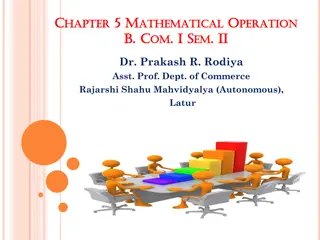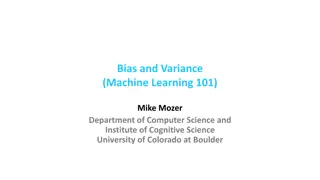Understanding Transition Bias and Substitution Models in Genetics
Transition bias and substitution models, explored by Xuhua Xia, delve into the concepts of transitions and transversions in genetic mutations, the causes of transition bias, the ubiquitous nature of transition bias in invertebrate and vertebrate genes, the mitochondrial genetic code, and RNA secondary structure. Transition bias refers to deviations from the expected s/v ratio and is influenced by mutation bias and selection bias. The genetic code illustrates synonymous and nonsynonymous mutations, while RNA structure is influenced by base pairing preferences. Lord Kelvin's quote reflects on the importance of quantifying knowledge in science.
Download Presentation

Please find below an Image/Link to download the presentation.
The content on the website is provided AS IS for your information and personal use only. It may not be sold, licensed, or shared on other websites without obtaining consent from the author. Download presentation by click this link. If you encounter any issues during the download, it is possible that the publisher has removed the file from their server.
E N D
Presentation Transcript
Transition Bias and Substitution models Xuhua Xia xxia@uottawa.ca http://dambe.bio.uottawa.ca
Transitions and Transversions Purine Transition: the substitution of a purine for a purine or a pyrimidine for a pyrimidine. Symbolized by s. A G Pyrimidine C T A G Transversion: the substitution of a purine for a pyrimidine or vice versa. Symbolized by v. C T What is transition bias? Transition bias refers to the degree by which the s/v ratio deviates from the expected 1/2. The observed s/v ratio is almost always much larger than 1/2. A G C T Xuhua Xia
Transition Bias is Ubiquitous. Why? For both invertebrate and vertebrate genes: obs s v 1 2 obs What causes transition bias? Mutation bias Selection bias obs s v s s P P Selection bias in fixation probability = Protein-coding genes RNA genes obs v v Mutation bias Xuhua Xia
Mitochondrial Genetic Code Synonymous and nonsynonymous Amino acid Amino acid Amino acid Amino acid Codon Codon Codon Codon UUU UUC UUA UUG Phe Phe Leu Leu UCU UCC UCA UCG Ser Ser Ser Ser UAU UAC UAA UAG Tyr Tyr Stop Stop UGU UGC UGA UGG Cys Cys Trp Trp Degeneracy: Non-degenerate CUU CUC CUA CUG Leu Leu Leu Leu CCU CCC CCA CCG Pro Pro Pro Pro CAU CAC CAA CAG His His Gln Gln CGU CGC CGA CGG Arg Arg Arg Arg Two-fold degenerate Four-fold degenerate AUU AUC AUA AUG lle Ile Met Met ACU ACC ACA ACG Thr Thr Thr Thr AAU AAC AAA AAG Asn Asn Lys Lys AGU AGC AGA AGG Ser Ser Stop Stop Transitions are synonymous and transversions are nonsynonymous at two-fold degenerate sites. GUU GUC GUA GUG Val Val Val Val GCU GCC GCA GCG Ala Ala Ala Ala GAU GAC GAA GAG Asp Asp Glu Glu GGU GGC GGA GGG Gly Gly Gly Gly Xuhua Xia
RNA secondary structure CCAAU CCAAU CCAAU CCAAU Seq1: CACGA ||||| GUGCU Seq1: CACGA ||||| GUGCU Seq2: CAUGA ||||| GUGCU Seq2: CGCGA ||||| GUGCU G/U pair, although not as strong as A/U or C/G pair, generally does not disrupt RNA secondary structure (and occurs frequently in RNA secondary structure). Xuhua Xia
Causes of transition bias obs s v s s P P = obs v v I often say that when you can measure what you are speaking about, and express it in numbers, you know something about it; but when you cannot measure it, when you cannot express it in numbers, your knowledge is of a meagre and unsatisfactory kind; it may be the beginning of knowledge, but you have scarcely in your thoughts advanced to the state of Science, whatever the matter may be." Lord Kelvin: Phys. Letter A, vol. 1, "Electrical Units of Measurement", 1883-05-03 Xuhua Xia
At Four-fold Degenerate Sites Glycine codon: At four-fold degenerate sites, all nucleotide substitutions are synonymous and subject to roughly the same selection pressure (similar fixation probabilities) GGA GGC GGG GGT Gly Asn Lys Gly Asp Lys Ala Ala Pro Ala Cys ... Fold 4 2 2 2 2 4 4 4 2 S1 GGA AAU AAA GGA GAC AAA GCC GCC CCU GCG UGU ... S2 GGG AAC AAA GAA GAU AAG GCC GCU CCA GGG UGG ... s s v Glu Gly Trp obs s v P P s s s = 2 Four-fold degenerate site obs v v v Xuhua Xia
At Nondegenerate Sites At nondegenerate sites, all nucleotide substitutions are nonsynonymous and subject to roughly the same selection pressure (similar fixation probabilities) Glycine codon: GGA GGC GGG Gly Asn Lys Gly Asp Lys Ala Ala Pro Ala Cys ... S1 GGA AAU AAA GGA GAC AAA GCC GCC CCU GCG UGU ... S2 GGG AAC AAA GAA GAU AAG GCC GCU CCA GGG UGG ... s v Glu Gly Trp GGT obs s v P P s s s = 2 nondegenerate site obs v v v Xuhua Xia
At Two-fold Degenerate Sites At two-fold degenerate sites, all transitional substitutions are synonymous, and all transversional substitutions are nonsynonymous GAA His GAG His GAC Gln GAT Gln Gly Asn Lys Gly Asp Lys Ala Ala Pro Ala Cys ... Fold 4 2 2 2 2 4 4 4 2 S1 GGA AAU AAA GGA GAC AAA GCC GCC CCU GCG UGU ... S2 GGG AAC AAA GAA GAU AAG GCC GCU CCA GGG UGG ... s s s v Glu Gly Trp obs s P P s s s = = 2 80 2-fold degenerate site obs v A transition is about 40 time as like to become fixed as a transversion. P P v v v Xuhua Xia
Methylation and deamination H3C- Methyltransferase H3C- + Donor Acceptor Xuhua Xia
Methylation and DNA Repair in E. coli DNA alphabets: ACGT RNA alphabets: ACGU DNA duplication and Watson-Crick paring rule: A-T, C-G H3C H3C H3C 3 --CTAG----CTAGGTAT----C-----C--CTAG-----------5 |||| |||||||| ? ? |||| 5 --GATC----GATCCATA----U-----T--GATC-----... 3 H3C mutL mutH mutS Spacing of GATC: consequences of being too far. Xuhua Xia
Methylation-Modification System Bacterial Genome Methylase TGGC*CA AC*CGGT Transcription and Translation Restriction enzyme ----TGG|CCA--- ----ACC|GGT--- Bacterial Membrane dsDNA phage Brevibacterium albidum Xuhua Xia
CpG-Specific DNA Methylation Mammalian DNA methyltransferase 1 (DNMT1) NLS-containing domain replication foci-directing domain ZnD, Zn-binding domain polybromo domain CatD, the catalytic domain CpG mCpG mCpG 748 343 609 1110 1 RFDD PBD NlsD ZnD CatD 350 746 1620 613 1124 Fatemi, M., A. Hermann, S. Pradhan and A. Jeltsch, 2001 J Mol Biol 309: 1189-99. Xuhua Xia
CpG-Specific DNA Methylation H3C H3C 5 ATGCGA-------CCGA--------ACGGC--TAA 3 |||||| |||| ||||| 3 TACGCT-------GGCT--------TGCCG--ATT 5 H3C Fully methylated Hemi-methylated Unmethylated Note: 5 CG3 = CpG Xuhua Xia
Methylation and Gene Regulation Proteins with a methyl-CpG binding domain (MBD) MBD1, MBD2, and MBD3 MeCP2 Deacetylases: An enzyme that removes an acetyl group Histone deacetylases: deacetylate lysyl residues in histones (the half life of an acetyl group is ~10min). Acetylation removes a positive charge on the lysine - amino group and promote nucleosome melting (and gene expression). Deacetylation tend to decrease or turn off gene expression. Histone deacetylase Condensed DNA with repressed transcription MBD ---mCpG----------------- Wade, P. A., and A. P. Wolffe, 2001 Nat Struct Biol 8: 575-7. Lysine demethylation Xuhua Xia
Methylation and Mutation NH2 O Spontaneous deamination O H3C H3C methylation N N O N O N Cytocine is converted to Thymine Xuhua Xia Slide 16
Vertebrate mitochondrion Parental H OH Parental L Daughter H Daughter L OL Xuhua Xia
Spontaneous deamination NH2 NH2 NH2 O CH3 N N N N N NH N H N H N H O N H O N N NH2 Adenine Guanine Cytosine Methylcytosine H2O H2O H2O H2O NH3 NH3 NH3 O NH3 O O O CH3 N N N N NH NH N H O N H N H O N H N O N H Hypoxanthine Xanthine (Pair with C) (Pair with C) Uracil (Pair with A) (Pair with A) Thymine Xuhua Xia
Transversion can erase transitions Transitions can erase transitions, and transversions can erase transversions. However, a transversion can erase many transitions occurring before it, and subsequent transitions cannot erase the transversion: AACGCTTGACG AACGCTTAACG AACGCTTGACG AACGCTTTACG AACGCTTAACG AACGCTTGACG AACGCTTGACG AACGCTTCACG AACGCTTTACG Although a transition could also erase 2n transversions occurring before it, this is rare because transversions are in generally much rarer than transitions. Transitions tend to be missed in counting much more frequently than transversions. Xuhua Xia
Summary Selection: Transitions are tolerated more than transversion by natural selection because they are more likely synonymous in protein-coding sequences than transversions they are less likely to disrupt RNA secondary structure than transversions. Mutation: Transitional mutation occurs more frequently than transversions because Misincorporation during DNA replication occur more frequently between two purines or between two pyrimidines than between a purine and a pyrimidine A purine is more likely to mutate chemically to another purine than to a pyrimidine (e.g., through spontaneous deamination) . The same for pyrimidine. Bias in counting: Transitions tend to be missed in counting much more frequently than transversions (which necessitates the substitution models) Xuhua Xia
Nucleotide Substitutions ACACTCGGATTAGGCT coincidental convergent parallel single ATACTCAGGTTAAGCT Observed sequences ACACTCGGATTAGGCT ACAATCCGGTTAAGCT multiple back T C C From WHL AGACTCGGATTAGGCT Actual number of changes during the evolution of the two daughter sequences: 12 Observed number of differences between the two daughter sequences: 3. Correcting for multiple substitutions to to estimate the true number of changes, i.e., 12. Xuhua Xia
Substitution models and phylogenetics A substitution model is to model the evolutonary process so as to correct for multiple hits. A phylogenetic reconstruction method implicitly or explicitly assumes a substitution model. A phylogenetic method assuming a wrong substitution model will typically lead to wrong trees produced. An alignment with an inappropriate substitution score matrix will typically lead to inaccurate alignment (e.g., strong transition bias among sequences but a substitution score matrix without strong penalty against transversion) A G C T Xuhua Xia
The diagonal of a transition probability matrix is subject to the constraint that each row sums up to 1. JC69 i = 0.25 ai = c K80 i =0.25 a1 = a6 = a7 = a12 = a2 = a3 = a4 = a5 = a8 = a9 = a10 = a11= F81/TN84 A, C, G, T ai = c Unrestricted: no equilibrium i A G a1 C a2 a4 T a3 a5 a6 HKY85 A, C, G, T a1 = a6 = a7 = a12 = a2 = a3 = a4 = a5 = a8 = a9 = a10 = a11= A G a7 C a8 T a10 a11 a12 a9 A G a1 Ga2 C a3 T a4 C a5 T C T TN93 A, C, G, T a1 = a7 = 1 a6 = a12 = 2 a2 = a3 = a4 = a5 = a8 = a9 = a10 =a11= A G a1 A C a2 A a4 G T a3 A a5 G a6 C a6 T GTR
The TN93 model as an example T C A G . A G 1 C A G . 1 T A G = Q . C T 2 T C G . 2 T C A - frequency parameters - rate ratio parameters In addition to illustrated assumptions, it also assumes that the frequency and rate ratio parameters do not change over time, i.e., the substitution process is stationary. Xuhua Xia
Substitution Models There are three types of substitution models in molecular evolution Nucleotide-based Amino acid-based Codon-based Substitution models are characterized by two categories of parameters: the frequency parameters and the rate ratio parameters, and different models differ by their assumptions concerning these two categories of parameters. Substitution models, substitution score matrix and sequence alignment. Xuhua Xia























